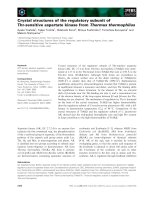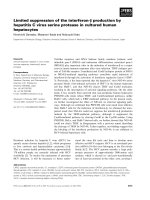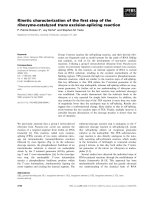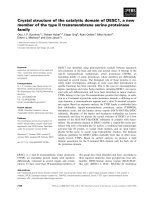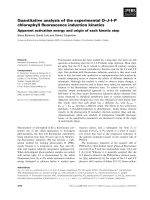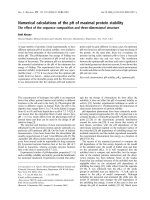Báo cáo khoa học: "Genetic variability of the prion protein gene (PRNP) in wild ruminants from Italy and Scotland" ppsx
Bạn đang xem bản rút gọn của tài liệu. Xem và tải ngay bản đầy đủ của tài liệu tại đây (695.8 KB, 6 trang )
JOURNAL OF
Veterinary
Science
J. Vet. Sci. (2009), 10(2), 115
120
DOI: 10.4142/jvs.2009.10.2.115
*Corresponding author
Tel: +39-11-2686367; Fax: +39-11-2686322
E-mail:
Genetic variability of the prion protein gene (PRNP) in wild ruminants
from Italy and Scotland
Simone Peletto
1,
*
, Matteo Perucchini
2
, Cristina Ac
í
n
3
, Mark P. Dalgleish
4
, Hugh W. Reid
4
, Roberto Rasero
5
,
Paola Sacchi
5
, Paula Stewart
2
, Maria Caramelli
1
, Ezio Ferroglio
5
, Elena Bozzetta
1
, Daniela Meloni
1
,
Riccardo Orusa
1
, Serena Robetto
1
, Silvia Gennero
1
, Wilfred Goldmann
2
, Pier Luigi Acutis
1
1
Istituto Zooprofilattico Sperimentale del Piemonte, Liguria e Valle d’Aosta, 10154 Turin, Italy
2
Neuropathogenesis Division, The Roslin Institute and Royal (Dick) School of Veterinary Studies, University of Edinburgh,
Roslin, Midlothian, EH25 9PS, UK
3
Department of Animal Pathology, Faculty of Veterinary Medicine, University of Zaragoza, 50013 Zaragoza, Spain
4
Moredun Research Institute, Pentlands Science Park, Bush Loan, Penicuik, Midlothian EH26 0PZ, UK
5
Department of Animal Productions, Epidemiology and Ecology, Faculty of Veterinary Medicine, University of Turin, 10095
Grugliasco, Italy
The genetics of the prion protein gene (PRNP) play a
crucial role in determining the relative susceptibility to
transmissible spongiform encephalopathies (TSEs) in
several mammalian species. To determine the PRNP gene
variability in European red deer (Cervus elaphus), roe deer
(Capreolus capreolus) and chamois (Rupicapra rupicapra), the
PRNP open reading frame from 715 samples was analysed to
reveal a total of ten single nucleotide polymorphisms (SNPs).
In red deer, SNPs were found in codons 15, 21, 59, 78, 79, 98,
136, 168 and 226. These polymorphisms give rise to 12
haplotypes, and one of which is identical to the PRNP of
American wapiti (Rocky Mountain elk, Cervus elaphus
nelsoni). One silent mutation at codon 119 was detected in
chamois and no SNPs were found in roe deer. This
analysis confirmed that European wild ruminants have a
PRNP genetic background that is compatible with TSE
susceptibility, including chronic wasting disease.
Keywords:
phylogenetic tree, polymorphism, PRNP, transmissible
spongiform encephalopathies, wild ruminants
Introduction
Chronic wasting disease (CWD) is a transmissible
spongiform encephalopathy (TSE) that has occurred in
North American cervids for more than 30 years [25].
Natural transmission to humans or domestic livestock
seems relatively unlikely, but the possibility still evokes
much concern from the public. There is currently no evidence
that TSEs (CWD, bovine spongiform encephalopathy, BSE or
scrapie) exist in cervids and other wild ruminants in European
countries [3,22,24]. Nevertheless, the European Union has
implemented active surveillance plans to estimate the
prevalence of CWD in the deer population.
An association between variation in the primary sequence
of the prion protein gene (PRNP) and disease modulation
has been shown for CWD and a number of studies have
analysed the genetic variability of the PRNP gene in North
American cervid species. Sequence analysis of the PRNP
from wapiti (Rocky Mountain elk, Cervus elaphus nelsoni)
revealed an amino acid change (Met to Leu) at codon 132:
homozygosity for Met132 was then found to be associated
with susceptibility [18]. These findings were supported by
studies on oral transmission that suggested that the Leu132
may protect against CWD [8]. However, a recent study on
CWD cases in free-ranging wapiti showed there was no
association of codon 132 with disease susceptibility [20].
Despite this, modulation of the incubation time of CWD by
the Leu132 allele is likely [6]. Mule deer (Odocoileus
hemionus) that are heterozygous for serine and phenylalanine
(S/F heterozygous) or F/F homozygous at codon 225 were
underrepresented in the infected population, suggesting there
is decreased susceptibility to CWD associated with these
genotypes [13]. PRNP polymorphisms encoding amino acid
substitutions were identified in white tailed deer
(Odocoileus virginianus), with substitutions at residues 65
(G→E), 95 (Q→H), 96 (G→S) and 116 (A→G) [9,19].
Polymorphisms at codons 95, 96 and 116 were found to
have a significant influence on the susceptibility to CWD
[14,15,19]. Amino acid variations at codons 100 (S→G)
116 Simone Peletto et al.
and 226 (E→Q) have been described in Chinese and
Korean captive sikadeer (Cervus nippon) [11,12]. PRNP
genetic variability in European wild ruminants has not
been thoroughly investigated, but the identification of
PRNP polymorphisms and comparing them with those in
North American cervids and domestic small ruminants
may provide an estimate of the susceptibility of these
species to CWD and other TSEs.
Materials and Methods
In this study, we describe nucleotide sequence variation
in the PRNP locus of red deer (Cervus elaphus), chamois
(Rupicapra rupicapra) and roe deer (Capreolus capreolus).
A total of 323 red deer samples were collected from
Scotland (n = 132; 82 from the mainland and 50 from the Isle
of Rhum) and during the hunting seasons from Italy (n =
191). The chamois (n = 203) and roe deer (n = 189) all came
from Italy and the sampling covered the whole Alpine arc.
Genomic DNA was isolated from blood or frozen muscle
tissue with the GenElute Mammalian DNA Kit (Sigma-
Aldrich, USA) or the Qiagen Tissue DNA extraction kit
(Qiagen, USA). The DNA segments corresponding to the
complete open reading frame (ORF) of the PRNP gene (771
bp) were amplified by performing PCR. The primers used for
the amplification and sequencing of the deer samples from
Scotland were 19fwd (5’ ATT TTG CAG ATA AGT CAT C
3’), 778rev (5’ AGA AGA TAA TGA AAA CAG GAA G 3’)
and 315fwd (5’ CAG TAA ACC AAA AAC CAA C 3’). A
detailed description of the PCR conditions has been
published by O’Rourke et al. [18]. The primers used for the
wild ruminant samples from Italy were p78 (+) (5’ TAA
GTG GGC ATA TGA TGC TG 3’), p79 () (5’ GGG CTG
CAG GTA GAC ACT C 3’), p61 (+) (5’ AAC CAA CAT GAA
GCA TGT GG 3’) and p60 () (5’ GAT AGT AAC GGT CCT
CAT AG 3’). PCR was performed according to a previously
described protocol [1]. The DNA sequencing reactions were
carried out using a BigDye Terminator Cycle Sequencing
Kit (Applied Biosystems, USA) and the DNA sequences
were analysed on an ABI 377 or ABI Prism 3130 Genetic
Analyser. Those sequences carrying novel variants have been
submitted to the GenBank database under the accession numbers
FJ436713-FJ436717. Departures from Hardy-Weinberg
equilibrium (HWE) were examined by using the probability
test as performed on the GENEPOP software [21]. Unbiased
estimates of genotypic disequilibrium were calculated with
GENEPOP by using the Markov chain method. The
parameters used for all the Markov chain procedures were
dememorization of 10,000 steps, 100 batches and 1,000
iterations per batch. The chi-square test for independence
was performed in order to establish differences in the allele
frequencies between the Scottish and Italian deer. The
genetic relationships among the red deer groups at the
PRNP locus were estimated using the chord distance (Dc)
with the assumption that all the changes of gene frequency
were due to genetic drift alone and that the population sizes
did not remain constant in all the groups over time [2].
Dendrograms were inferred by the neighbor-joining
method [23] with MEGA software [16]. Distance matrices
were determined under the assumptions of Kimura's
two-parameter model and the confidence values for the
individual branches of the resulting tree were determined
by bootstrap analysis with 1,000 replicates [4].
Results
In the red deer PRNP, four single-nucleotide polymorphisms
(SNPs) encoding amino acid changes were identified:
G59S, T98A, P168S and Q226E. Silent mutations were
found at codons 15, 21, 78 (which are all novel) (Fig. 1), 79
and 136. The red deer population from the Isle of Rhum
was in HWE for all the polymorphisms, while the
populations from mainland Scotland and from Italy were
not in HWE for SNPs at codons 15 (p < 0.001), 21 (p <
0.001), 226 (p = 0.0014), and 98 (p = 0.03), 136 (p = 0.01),
226 (p = 0.01), respectively. This was not unexpected
given that in both cases the sampling was carried out in
separated areas and this resulted in structured populations.
Tests for genotypic disequilibrium revealed that the same
linkage between SNPs at codons 136 and 226 (p < 0.001)
was present in all the individual populations.
The haplotypes inferred from the found polymorphisms
are reported in Table 1. The detailed allele and genotype
frequencies are separately summarized in Tables 2 and 3,
according to their geographical origin. The silent mutation
at codon 15 (gtg
→
gcg) was found only in the red deer from
mainland Scotland, while the synonymous substitution at
codon 21 revealed two allelic variants: gtc
→
gtt in the red
deer from mainland Scotland and gtc
→
gtg in the Italian
red deer. G59S (ggc
→
agc) and the silent mutation at codon
79 (ccc
→
cct) were both detected in single animals from
Italy. The G59S polymorphism is located in the first PrP
peptide repeat by replacing the fourth Gly of the GGGG
track. The silent mutation at codon 78 (cag
→
caa) was
found only in Italian red deer. The allele frequencies of the
T98A (acc
→
gcc) polymorphism in all red deer samples
were 92.26% and 7.74% for Thr98 and Ala98, respectively.
The allele frequencies were calculated by considering the
two animal populations separately and according to their
geographical origin, and this revealed a significantly
different distribution of these alleles (Chi-square = 5.65; p <
0.018). The P168S (cca
→
tca) polymorphism was found
only in one deer from the Isle of Rhum. The combination of
the silent mutation at codon 136 (gct
→
gcc) and the amino
acid change Q226E gave origin to all the possible four
haplotypes, but c was most frequently on a haplotype with
glutamic acid and t was linked to glutamine (Table 1).
However, the haplotype distribution in the studied
The PRNP gene in wild ruminants from Italy and Scotland 117
Fig. 1. Novel noncoding single nucleotide polymorphisms (SNPs) at codons 15, 21 and 78 in the red deer PRNP. Electropherograms
show one homozygous (codon 15) and three heterozygous (codons 21 and 78) genotypes. The SNP at codon 15 was detected only in
homozygosis in this study.
Tabl e 1 . Haplotypes identified in the analysed red deer and their frequencies in the population sample
15 21 59 78 79 98 136 168 226
Haplo Frequency
Val Val Gly/Ser Gln Pro Thr/Ala Ala Pro/Ser Gln/Glu
type (%)
gTg/gCg gtC/gtG(T) Ggc/Agc caG/caA ccC/ccT Acc/Gcc gcT/gcC Cca/Tca Cag/Gag
1 T C G G C A T C C 42.58
2 C - - - - - - - - 1.24
3 - G - - - - - - - 0.15
4 - T - - - - - - - 1.55
5 A 0.15
6 - - - A - - - - - 1.24
7 - - - - T - - - - 0.15
8 - - - - - G - - - 7.74
9 - - - - - - - T - 0.15
10 - - - - - - C - G 43.50
11 C-C 1.40
12 - - - - - - T - G 0.15
populations appeared to be different with the most frequent
haplotype being c
136
-E
226
(65.91%) in the Scottish red deer
while the t
136
-Q
226
haplotype prevailed in the Italian
animals (59.17%). This observation was confirmed by
statistical analysis (Chi-square = 38.27; p < 1 × 10
-7
). The
c
136
-Q
226
and t
136
-E
226
haplotypes were found only in
Scottish deer at low frequencies (1.40% and 0.15%,
respectively).
The Dc-based analysis of the genetic distances reflected
the geographical separation of the three red deer groups
included in this study. As expected, the highest genetic
distance value was between the red deer from Italy and
mainland Scotland (0.089). The distance value between
the Italian and Isle of Rhum deer was 0.078 and that
between Mainland Scotland and Isle of Rhum deer was
0.059.
In the chamois, sequencing analysis revealed the
presence of one synonymous mutation at codon 119 (gct
→
gcc). This polymorphism was found only in heterozygosis
and the allele frequency was 7.39%. No variation was
found in the roe deer PRNP and all the sequences were
identical to those already deposited in the GenBank
database. All the animals of the three species included in
the present study possessed five octapeptide repeats. The
118 Simone Peletto et al.
Tabl e 2 . Allele frequencies of the PRNP polymorphisms in red
deer from Italy and Scotland
Allele frequency (%)
Cervus Cervus
Codon Allele
elaphus elaphus elaphus scoticus
15 gtg (Val) 100.00 96.97
gcg (Val) - 3.03
21 gtc (Val) 99.73 96.21
gtg (Val) 0.27 -
gtt (Val) - 3.79
59 ggc (Gly) 99.73 100.00
agc (Ser) 0.27 -
78 cag (Gln) 97.91 100.00
caa (Gln) 2.09 -
79 ccc (Pro) 99.73 100.00
cct (Pro) 0.27 -
98 acc (Thr) 90.05 95.45
gcc (Ala) 9.95 4.55
136 gct (Ala) 71.99 37.88
gcc (Ala) 28.01 62.12
168 cca (Pro) 100.00 99.62
tca (Ser) - 0.38
226 cag (Gln) 71.99 31.44
gag (Glu) 28.01 68.56
Tabl e 3 . Genotype frequencies of the PRNP polymorphisms in
red deer from Italy and Scotland
Genotype frequency (%)
Cervus Cervus
Codon Genotype
elaphus elaphus elaphus scoticus
15 gtg/gtg 100.00 96.97
gtg/gcg
gcg/gcg -3.03
21 gtc/gtc 99.48 95.45
gtc/gtg -1.52
gtg/gtg -3.03
gtc/gtt 0.52 -
gtt/gtt
59 ggc/ggc 99.48 100.00
ggc/agc 0.52 -
agc/agc
78 cag/cag 96.34 100.00
cag/caa 3.14 -
caa/caa 0.52 -
79 ccc/ccc 99.48 100.00
ccc/cct 0.52 -
cct/cct
98 acc/acc 82.72 91.66
acc/gcc 14.66 7.58
gcc/gcc 2.62 0.76
136 gct/gct 55.50 27.27
gct/gcc 32.98 21.21
gcc/gcc 11.52 51.52
168 cca/cca 100.00 99.24
cca/tca -0.76
tca/tca
226 cag/cag 55.50 12.88
cag/gag 32.98 37.12
gag/gag 11.52 50.00
phylogenetic tree resulting from the alignment of the wild
ruminant PRNP sequences, together with the reported
sequences of other wild and domestic ungulates, is
represented in Fig. 2. The PRNP sequences revealed high
similarity among the red deer, roe deer and American
cervids and among the sheep, goat and chamois with the
result that they were grouped in two separate clusters of the
inferred dendrogram. Furthermore, these two groups were
more similar to each other than to bovine, which had the
most divergent PRNP of the considered species.
Discussion
Our results confirmed that the red deer PRNP carries
several polymorphic sites, and these give rise to different
variants of the mature PrP. However, the PRNP
polymorphisms associated with an increased susceptibility
to CWD in North American cervids were not found in the
European deer. All the animals analysed in this study were
methionine homozygous at codon 132. The haplotype
variant 10 is identical with the PRNP of wapiti, which
would make these carriers susceptible to CWD. The
mutations at codons 168 and 226 of red deer are located in
the β-sheet 2 and the α-helix 3, respectively [26]. Helix 3
has specific properties regarding protein stability, and any
amino acid change could imply a different electric charge
and a subsequently different conformation of PrP
C
protein.
The Q226E polymorphism is adjacent to codon 225, which
is associated with CWD susceptibility in mule deer. In
sheep, a proline to leucine substitution at codon 168 has
been associated with increased resistance to experimental
BSE inoculation [5]. A modulatory role on susceptibility
could be hypothesised for polymorphisms at codons 168
and 226 following the exposition of red deer to TSEs.
Despite the considerable number of animals analysed in
the present study, the PRNP sequence variability was
limited to one synonymous polymorphism in chamois and
no SNPs were detected in roe deer, showing that the PRNP
is conserved in these two species, at least in Italy. This
finding is quite unexpected considering the PRNP
variability of the other phylogenetically close species. Roe
deer belong to Cervidae, the same family as red deer and
The PRNP gene in wild ruminants from Italy and Scotland 119
Fig. 2. The phylogenetic tree of similarity among the PRNP gene sequences of the analysed wild ruminants and other wild and domestic
ungulates. The following representatives of the suborder Ruminantia have been included in the analysis: mule deer (Odocoileus
hemionus), white-tailed deer (Odocoileus virginianus), fallow deer (Cervus dama), mouflon (Ovis musimon), goat (Capra hircus),
Alpine ibex (Capra ibex), sheep (Ovis aries) and cow (Bos taurus). The GenBank accession numbers of the reference PRNP sequence
s
are indicated. Bootstraps values > 50 (1,000 replicates) are indicated at the internal nodes. The length of each pair of
b
ranches
represents the distance between sequence pairs. The scale bar represents the percentage of nucleotide differences.
American cervids whose PRNP coding region has revealed
several silent and coding SNPs. Chamois belong to the family
Bovidae, subfamily Caprinae, to which sheep and goats also
belong, and these two species are characterized by highly
polymorphic PRNP coding regions. The sequence alignment
of the chamois PRNP with the ovine and caprine PRNPs
showed high inter-species homology with a percentage
identity of 99.7% and 99.4%, respectively. Even the bovine
PRNP coding region, which has low genetic variability, is
not as conserved as the chamois PRNP coding region.
The PRNP genetics in European wild ruminants raises
interest not only for the possible introduction/circulation
of the CWD agent among wild species, but also because of
the widespread presence of scrapie across Europe and
consequently the possible exposure of wild ruminants to
the scrapie prion. There is evidence for occasionally
sharing of mountain grazes by European wild ruminants
with sheep and goats during the summer season. The TSE
agent has the ability to cross the species barrier [10,17] and
a hypothesis for the transmission of the scrapie agent to
wild ruminants could be reasonably formulated. Indeed,
six cases of scrapie were confirmed in two separately
maintained flocks of moufflon, and the disease appeared to
be endemic in both flocks [27]. The moufflon (Ovis
musimon) is one of four types of primitive sheep that are of
the same genus as domestic sheep. The analysis of PRNP
phylogenesis is commonly used as a criterion for predicting
a species’ susceptibility to prions and based on our results
particular attention should be given to the potential scrapie
susceptibility of chamois, which has a PrP amino acid
sequence identical to that of sheep and it is clustered with
sheep and goat even closer than is moufflon. As expected,
red deer and roe deer have a PRNP gene that is closer to the
species in which CWD occurs. Additionally, transmission
studies have also shown that intracerebral inoculation of a
sheep scrapie agent into wapiti resulted in spongiform
encephalopathy with accumulations of pathological PrP in
the central nervous system [7]. The preliminary data from
transgenic mice expressing CerPrP
C
- L132 suggests that
sheep scrapie isolate SSBP/1 is able to overcome the
protective effect of the L132 allele [6]. Thus, the association
of PRNP polymorphisms with TSE disease could be quite
unexpected for wild ruminant species due to the interaction
of different hosts to agent-strain combinations.
In conclusion, the genetic analysis carried out in the
present study shows that European wild ruminants can be
susceptible to TSEs. This highlights the importance of
surveillance programmes and it suggests that these species
have a possible role as reservoirs for livestock prion
diseases.
Acknowledgments
Funding for this project was provided from the Ministry
of Health grant IZSPLV 08/03 RC to S.P. and P.L.A., from
the Biotechnology and Biological Sciences Research
Council, U.K. to M.P., P.St. and W.G.
References
1. Belt PB, Muileman IH, Schreuder BE, Bos-de Ruijter J,
Gielkens AL, Smits MA. Identification of five allelic
variants of the sheep PrP gene and their association with
natural scrapie. J Gen Virol 1995, 76, 509-517.
120 Simone Peletto et al.
2. Cavalli-Sforza LL, Edwards AWF. Phylogenetic analysis.
Models and estimation procedures. Am J Hum Genet 1967,
19, 233-257.
3. De Bosschere H, Saegerman C, Neukermans A, Berkvens
D, Casaer J, Vanopdenbosch E, Roels S. First chronic
wasting disease (CWD) surveillance of roe deer (Capreolus
capreolus) in the northern part of Belgium. Vet Q 2006, 28,
55-60.
4. Felsenstein J. Evolutionary trees from DNA sequences: a
maximum likelihood approach. J Mol Evol 1981, 17, 368-
376.
5. Goldmann W, Houston F, Stewart P, Perucchini M,
Foster J, Hunter N. Ovine prion protein variant A (136) R
(154) L (168) Q (171) increases resistance to experimental
challenge with bovine spongiform encephalopathy agent. J
Gen Virol 2006, 87, 3741-3745.
6. Green KM, Browning SR, Seward TS, Jewell JE, Ross
DL, Green MA, Williams ES, Hoover EA, Telling GC.
The elk PRNP codon 132 polymorphism controls cervid and
scrapie prion propagation. J Gen Virol 2008, 89, 598-608.
7. Hamir AN, Miller JM, Cutlip RC, Kunkle RA, Jenny AL,
Stack MJ, Chaplin MJ, Richt JA. Transmission of sheep
scrapie to elk (Cervus elaphus nelsoni) by intracerebral
inoculation: final outcome of the experiment. J Vet Diagn
Invest 2004, 16, 316-321.
8. Hamir AN, Gidlewski T, Spraker TR, Miller JM,
Creekmore L, Crocheck M, Cline T, O'Rourke KI.
Preliminary observations of genetic susceptibility of elk
(Cervus elaphus nelsoni) to chronic wasting disease by
experimental oral inoculation. J Vet Diagn Invest 2006, 18,
110-114.
9. Heaton MP, Leymaster KA, Freking BA, Hawk DA,
Smith TP, Keele JW, Snelling WM, Fox JM,
Chitko-McKown CG, Laegreid WW. Prion gene sequence
variation within diverse groups of U.S. sheep, beef cattle,
and deer. Mamm Genome 2003, 14, 765-777.
10. Li L, Coulthart MB, Balachandran A, Chakrabartty A,
Cashman NR. Species barriers for chronic wasting disease
by in vitro conversion of prion protein. Biochem Biophys
Res Commun 2007, 364, 796-800.
11. Meng LP, Zhao DM, Liu HX, Yang JM, Ning ZY, Wu
CD, Han CX. Polymorphisms of the prion protein gene
(PRNP) in Chinese domestic sika deer (Cervus nippon
hortulorum). Anim Genet 2005, 36, 266-267.
12. Jeong HJ, Lee JB, Park SY, Song CS, Kim BS, Rho JR,
Yoo MH, Jeong BH, Kim YS, Choi IS.
Identification of
single-nucleotide polymorphisms of the prion protein gene
in sika deer (Cervus nippon laiouanus). J Vet Sci 2007, 8,
299-301.
13. Jewell JE, Conner MM, Wolfe LL, Miller MW, Williams
ES. Low frequency of PrP genotype 225SF among free-
ranging mule deer (Odocoileus hemionus) with chronic
wasting disease. J Gen Virol 2005, 86, 2127-2134.
14. Johnson C, Johnson J, Clayton M, McKenzie D, Aiken J.
Prion protein gene heterogeneity in free-ranging white-
tailed deer within the chronic wasting disease affected region
of Wisconsin. J Wildl Dis 2003, 39, 576-581.
15. Johnson C, Johnson J, Vanderloo JP, Keane D, Aiken
JM, McKenzie D. Prion protein polymorphisms in
white-tailed deer influence susceptibility to chronic wasting
disease. J Gen Virol 2006, 87, 2109-2114.
16. Kumar S, Tamura K, Nei M. MEGA3: integrated software
for Molecular Evolutionary Genetics Analysis and sequence
alignment. Brief Bioinform 2004, 5, 150-163.
17. Moore RA, Vorberg I, Priola SA. Species barriers in prion
diseases brief review. Arch Virol 2005, 19 (Suppl), 187-
202.
18. O'Rourke KI, Besser TE, Miller MW, Cline TF, Spraker
TR, Jenny AL, Wild MA, Zebarth GL, Williams ES. PrP
genotypes of captive and free-ranging Rocky Mountain elk
(Cervus elaphus nelsoni) with chronic wasting disease. J
Gen Virol 1999, 80, 2765-2769.
19. O'Rourke KI, Spraker TR, Hamburg LK, Besser TE,
Brayton KA, Knowles DP. Polymorphisms in the prion
precursor functional gene but not the pseudogene are
associated with susceptibility to chronic wasting disease in
white-tailed deer. J Gen Virol 2004, 85, 1339-1346.
20. Perucchini M, Griffin K, Miller MW, Goldmann W. PrP
genotypes of free-ranging wapiti (Cervus elaphus nelsoni)
with chronic wasting disease. J Gen Virol 2008, 89,
1324-1328.
21. Raymond M, Rousset F. GENEPOP (version 1.2): population
genetics software for exact tests and ecumenicism. J Hered
1995, 86, 248-249.
22. Roels S, Saegerman C, De Bosschere H, Berkvens D,
Gregoire F, Hoyoux A, Mousset B, Desmecht D,
Vanopdenbosch E, Linden A. First results of chronic
wasting disease (CWD) surveillance in the south-eastern
part of Belgium. Vet Q 2005, 27, 98-104.
23. Saitou N, Nei M. The neighbor-joining method: a new
method for reconstructing phylogenetic trees. Mol Biol Evol
1987, 4
, 406-425.
24. Schettler E, Steinbach F, Eschenbacher-Kaps I, Gerst K,
Muessdoerffer F, Risch K, Streich WJ, Fr
ö
lich K.
Surveillance for prion disease in cervids, Germany. Emerg
Infect Dis 2006, 12, 319-322.
25. Sigurdson CJ, Aguzzi A. Chronic wasting disease. Biochim
Biophys Acta 2007, 1772, 610-618.
26. Stahl N, Borchelt DR, Hsiao K, Prusiner SB. Scrapie prion
protein contains a phosphatidylinositol glycolipid. Cell
1987, 51, 229-240.
27. Wood JL, Lund LJ, Done SH. The natural occurrence of
scrapie in moufflon. Vet Rec 1992, 130, 25-27.


